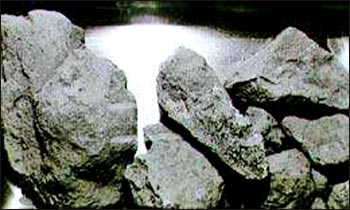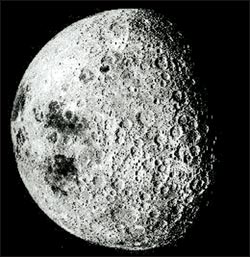How to breathe on the Moon
Katharine Sanderson
Scientists in Cambridge, UK, have developed a reactor that can make
oxygen from Moon rock, a vital technology if plans to create a lunar
base are to take off.
Whether tapping the Moon’s resources or using the satellite as a
jump-off point to explore the deeper reaches of space, occupants of any
future lunar base will need oxygen to survive. Ferrying huge amounts of
it to the Moon would be extremely expensive, perhaps costing as much as
US$100 million per tonne according to some estimates, so researchers are
examining potentially cheaper ways to produce oxygen on the Moon itself.
|

Moon rocks could be a source of oxygen for a future lunar base |
NASA has been looking for ways to get oxygen from Moon rock for
several years. In 2005, as part of its Centennial Challenges program,
the agency offered a US$250,000 prize to the first team to come up with
a piece of kit that could extract five kilograms of oxygen in eight
hours from some simulated Moon rock. Despite raising the value of the
prize pot to $1 million in 2008 with the help of the California Space
Authority, the prize remains unclaimed.
In addition, the agency’s ongoing In Situ Resource Utilization
program is currently looking at several different technologies for
extracting oxygen from Moon rock.
Now, Derek Fray, a materials chemist from the University of
Cambridge, UK, and his colleagues have come up with a potential solution
by modifying an electrochemical process they invented in 2000 to get
metals and alloys from metal oxides.
The process uses the oxides, also found in Moon rocks, as a cathode,
together with an anode made of carbon. To get the current flowing
through the system, the electrodes sit in an electrolyte solution of
molten calcium chloride (CaCl2), a common salt with a melting point of
almost 800 °C.
Eroding anode
The current strips the metal oxide pellets of oxygen atoms, which are
ionized and dissolve in the molten salt. The negatively charged oxygen
ions move through the molten salt to the anode where they give up their
extra electrons and react with the carbon to produce carbon dioxide, a
process that erodes the anode. Meanwhile, pure metal is formed over at
the cathode.
To make the system produce oxygen and not carbon dioxide, Fray had to
make an un-reactive anode. This was crucial: “Without those anodes, it
doesn’t work”, says Fray.
He discovered that calcium titanate, which is a poor electrical
conductor on its own, became a much better conductor when he added some
calcium ruthenate to it.
|

Flying oxygen to the Moon is likely to be expensive. |
This mixture produced an anode that barely erodes at all, after
running the reactor for 150 hours, Fray calculated that the anode would
wear away by roughly three centimetres a year.
In their tests, Fray and his colleagues used a simulated lunar rock
called JSC-1, developed by NASA. Fray anticipates that three reactors,
each a metre high, would be enough to generate a tonne of oxygen per
year on the Moon.
Three tonnes of rock are needed to produce each tonne of oxygen, and
in tests the team saw almost 100 percent recovery of oxygen, he says.
Fray presented the results last week at the Congress of the
International Union of Pure and Applied Chemistry in Glasgow, UK.
To heat the reactor on the Moon would need just a small amount of
power, Fray notes, and the reactor itself can be thermally insulated to
lock heat in. “It won’t be a problem”, he says.
Robust prototype
The three reactors would need about 4.5 kilowatts of power, not much
more than that used to heat an immersion heater in a domestic boiler,
which could be supplied by solar panels or even a small nuclear reactor
placed on the Moon.
With an extra £10 million (US$16.5 million), Fray says he would be
able to develop ‘a robust prototype’ of a bigger reactor that could be
operated remotely.
He is currently working with the European Space Agency towards this
goal.
A similar technique for oxygen extraction is being developed by
Donald Sadoway at the Massachusetts Institute of Technology in
Cambridge, Massachusetts, but his process works at a much higher
temperature of up to 1600 °C, which means that the Moon rock is molten
and can act as the electrolyte itself.
Molten metal
It produces molten metal, including iron, which sinks to the bottom.
Fray says that his process is more efficient because it works at a
lower temperature, but Sadoway insists that molten salt electrolysis, as
his technique is called, makes up elsewhere for the extra heat it needs.
“In Derek’s process, the molten salt allows him to operate at a much
lower temperature”, says Sadoway, but he still has to consolidate the
Moon rock into a solid form. This is often difficult because of the fine
sandy nature of Moon rock, he says.
Sadoway’s reactor could even build itself. The interior would be Moon
regolith, the powdery rubble that forms the Moon’s surface, heated
electrically to become molten, and the exterior would be solid regolith
that has cooled. “We form the wall of the reactor by allowing the molten
regolith to freeze”, he says, but admits that starting the process is
‘tricky’.
Sadoway says that with sufficient funding, he could have his system
scaled up within two years. His process has been short-listed by NASA
and is receiving some funding from the agency. “Once we solve the
materials problems at the lab scale we should be able to move quickly”,
he says.
Courtesy Nature News |



